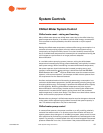
System Issues and Challenges
SYS-APM001-EN Chiller System Design and Control 83
situation. Electrical generation can be outsourced to avoid internal
capitalization.
A variation of electrical generation uses an engine indirectly- or directly-
coupled to a chiller. Either variation produces chilled water using an
alternative fuel such as natural gas or fuel oil. The indirect-coupling method
allows the chiller to operate using an alternative fuel or electricity from the
grid. An engine directly-coupled to a chiller can only run using the alternative
fuel.
Alternative fuel
Some designers prefer to employ chillers that use fossil fuels or perhaps
renewable fuels. Examples are absorption chillers using natural gas, steam,
hot water, landfill gas, biodiesel, or waste-to-energy boilers. Plants with these
chillers, discussed in detail elsewhere
30
, allow the owner to take advantage
of expected fuel rate separations.
Thermal storage
Another successfully applied alternative-energy source is thermal storage.
Chillers make either ice or chilled water during times of lower electricity
costs. The energy is stored in tanks and then discharged to satisfy cooling
loads during times of high electrical costs. Other manuals and an Engineers
Newsletter describe the use of thermal storage in detail.
31, 32, 33, 34, 35
Use any of these technologies to provide value to the building owner through
judicious use of alternative fuels.
Plant Expansion
Plant expansion can be performed easily in either a primary–secondary or
variable-primary-flow system by adding another chiller and pump to the
system. The two major considerations will be whether the chilled-water
distribution pipes will be able to handle the flow and how to install the new
chiller while other chillers are still providing cooling. When the new system
flow rate complies with good piping practice and the pumps can deliver the
water, the process works well.
To maintain chilled-water flow during installation of a new chiller, some
plants are constructed with piping stubs in place for the new chiller. In this
way, the new chiller can be installed while the system is still operating, then
the valves in the stubs can be opened.
When decoupled systems are used on large campus-type systems, added
loads are often located some distance away from the original loads. Yet,
planners like the idea of somehow hooking the new loads to the existing
system. The “double-ended” system discussed in “Chiller sequencing in a
double-ended decoupled system” on page 54 is one way of handling this
requirement.


















